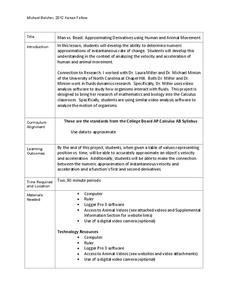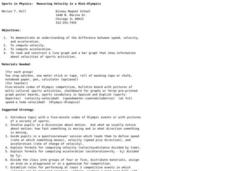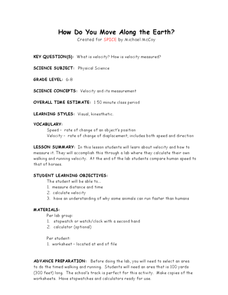Curated OER
"Measurement in Motion"
Ninth graders examine the rate of motion and changes in motion using a ramp and a rolling object. They conduct the demonstration, determine the average speed, and describe how a moving object can have zero acceleration and deceleration.
Curated OER
Acceleration and Average Speed
In this acceleration and average speed worksheet, students learn the equations for acceleration and average speed. They match 6 variables with their quantities, they identify speed vs. velocity and scalar vs. vector and they solve 4...
Kenan Fellows
Man vs. Beast: Approximating Derivatives using Human and Animal Movement
What does dropping a ball look like as a graph? An engaging activity asks learners to record a video of dropping a ball and uploading the video to software for analysis. They compare the position of the ball to time and calculate the...
Florida International University
Are You Concentrating?
Explore the importance of a concentration gradient in the rates of dissolution. Using the ocean ecosystem, learners study rates of dissolution around coral reefs. A hands-on experiment helps individuals discover the effects of changing a...
Project Maths
Introduction to Calculus
Don't let your class's heart rates rise as you introduce them to differentiation ... an inquiry-based lesson helps them keep it in check! The second lesson in a three-part series asks learners to analyze the rate of change of different...
Edmond Public Schools
8th Grade Science Resource Book: Unit 2 - Physics
Get things moving with this extensive collection of physical science resources. Covering the fundamentals of measurement, graphing, lab safety, and experimental design as well as the specific scientific concepts of velocity,...
Curated OER
Motion and Force
Motion and force vocabulary words are concisely defined in this 13-slide PowerPoint. This is a great slideshow to review prior to a quiz for 5th or 6th grade science. Tip: Send this PowerPoint to your students so they can review it...
Physics Classroom
Acceleration
The acceleration rate of a flea jumping works out to 50 times faster than the acceleration rate of the space shuttle. Pupils apply knowledge of acceleration to dot diagrams, velocity-time tables, and word problems. They solve for...
Illustrative Mathematics
Distance across the channel
Here you will find a model of a linear relationship between two quantities, the water depth of a channel and the distance across the channel at water level. The cross section of the channel is the shape of an isosceles trapezoid. The...
National Council of Teachers of Mathematics
Varying Motion
For this secondary mathematics learning exercise, high schoolers collect data based on a person’s motion. From this data, students create graphs comparing displacement, velocity, and acceleration to time. The five-page learning exercise...
Curated OER
Sports in Physics: Measuring Velocity in a Mini-Olympics
Eighth graders examine the difference between speed, velocity and acceleration. For this velocity lesson students read and construct a line graph and a bar graph to show information about velocities of sports activities.
Curated OER
Waves Velocity & Particle Velocity
In this physics worksheet, students examine a single wave pulse which travels down a slinky. Then they sketch a single ring of the slinky as the wave goes by and determine whether the wave is constant or not.
Curated OER
Rates Of Change
High schoolers investigate the rate of change and how it effects a function over a given interval. They examine the slope of a line that is seccant and how it is compared to a tangent line and then determine the changes of a function at...
College Board
2010 AP® Calculus AB Free-Response Questions Form B
Most say that practice makes perfect. Scholars use the released free-response questions to practice for the AP® Calculus AB exam. Each question comes with several parts and either do or do not allow calculators. Items include topics such...
College Board
2011 AP® Calculus AB Free-Response Questions Form B
Half are real-world. The 2011 AP® Calculus AB free-response questions let pupils and teachers see how content appears on the exam. Half of the questions contain real-world context, and four items do not allow calculators. Real-world...
College Board
2003 AP® Calculus BC Free-Response Questions Form B
Be integral to the learners in the classroom. Pupils use integrals, differentiation, and limits to solve the free-response questions from an AP® Calculus BC exam. Items cover topics such as area under a curve, particle motion, average...
College Board
2004 AP® Calculus AB Free-Response Questions Form B
The test is not all about skills. The six free-response questions contain two real-world application problems. Those items deal with populations and velocities. The other four questions ask pupils to show their knowledge of calculus...
Curated OER
What is Motion?
In this motion worksheet, students will write in motion vocabulary words including velocity and speed to complete 7 statements. Then students will calculate average speed and velocity in three short answer questions.
Curated OER
Marble Madness
Students determine the velocity of a marble rolling down the incline. In this physics lesson plan, students identify the independent and dependent variables in the experiment. They construct and analyze a graph.
Curated OER
How Do You Move Along the Earth?
Students determine their own walking and running velocity. In this physics lesson, students calculate velocity using distance and time information. They compare human and animal speeds.
Curated OER
Motion
For this motion worksheet, students will read 8 statements about displacement and velocity and determine if the statement is true or false. Then students will fill in the blank for 8 statements on motion. Finally, students will compare...
Curated OER
Vectors: Follow That Arrow
Vectors and their connection to motion. A video will be presented to provide information for the class to use methods of solving vectors with and without grids. Real-world physical concepts will be explored in reference to vectors.
Curated OER
Worksheet 15 - Differentiation
In this differentiation worksheet, students determine the seconds of motion, identify the constant, and speed of movement. This two-page worksheet contains five multi-step problems.
Curated OER
Tracking Speed
Students calculate the speed of an object, by measuring the amount of time it takes to cover a given distance, and then divide: speed=distance/time. However, the object may not have been moving at a constant rate over the given distance....

























